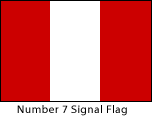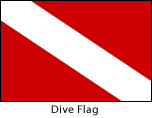The story of the scuba diver down flag
Dive Flag Clip Art | Dive Flag Law
The now-familiar red-and-white dive flag was invented in the early 1950’s by Denzel James “Doc” Dockery from Michigan. Do you want to read more about Dive Flags from your phone, but the file-size is huge? No problem! Try PDF Compressor to compress PDF files for free!
Dockery was a tinker and entrepreneur. In 1953, he followed instructions published in Popular Science magazine for building his own scuba unit, and began experimenting with ways to make a living in the brand new sport.
In the course of his work, Dockery found that he needed a warning flag to keep boaters at a safe distance. Since Dockery had served in the U.S. Navy, he was familiar with the red signal flag that’s commonly used to connote danger. The Navy’s “bravo flag” is solid red. 1

In order to make his flag distinctive, Dockery decided to make a modification. He asked his wife Ruth to sew a white stripe across the middle of it. They put their stripe horizontal, right down the center from left to right.
Unfortunately, there was a problem with their design. It was the national flag of Austria. They needed something else. A vertical white stripe was out since that’s the Navy’s numerical number 7 signal flag.

After doing their homework, they decided to make the stripe diagonal. Ruth sewed it from the upper-left corner to the lower-right corner. The dive flag, as we now know it, was born.

Inventing a flag is one thing. Getting it used and recognized is another. Perhaps more important than his role in creating the dive flag was Dockery’s evangelism for it. With the persistent tenacity of a good entrepreneur 2 Dockery began selling flags and promoting their use.
In 1956, Dockery’s flag got a major boost. Ted Nixon from U.S. Divers started buying them from him and distributing them nationally. Nixon became so instrumental in the flag’s widespread adoption that many people mistakenly credit Nixon with inventing the flag.
Another boost came from Skin Diver magazine. They mentioned Dockery’s flag in a September 1957 editorial and asked their readers to send in their thoughts on the design. In February 1958, they declared the discussion closed, with the “Michigan Divers Flag” as the reader’s choice. 3
In addition to promoting it among divers, Dockery worked to get the flag officially recognized in his home state of Michigan. He was successful, and Michigan became the first state in the union with a diver flag law. Now, thanks to what he started, the federal government and almost every U.S. state officially recognizes Dockery’s flag as the official warning sign of a diver down.
Notes
- What is today called the “bravo flag” Dockery would have called the “baker flag.” This is simply a reflection of the difference in the way the U.S. Navy refers to the alphabetical signal flag for the letter “B.” In 1956, the Navy adopted the international standards for the phonetic alphabet, and therefore started using “bravo” instead of “baker” when referring to the letter B.Although used as the letter B, the bravo flag is flown to tell other ships: “I am taking in, discharging, or carrying dangerous cargo.” Here is more on the Navy’s . For more on Dockery, see “” by Fat Boy Scuba.
- Dockery’s business ultimately evolved into Vortex Innerspace Products, a very successful producer of aquarium filters. The company is now based in Florida and managed by Dockery’s son Daryl.
- See “” in Skin Diver’s Nuggets of Yesteryear by Tamara Collins. Here is a scan of the original Skin Diver editorial mentioning the dive flag.
Sincerely,

Chris Whitten
chris-(@)-interesting.com (remove the hyphens and parentheses)
Dive-Flag.com Webmaster
P.S. The dive flag law pages with rules and regulations for divers and boaters in all fifty US states is incomplete. There’s a lot of information there but I still need help. If you have anything to add please let me know. Thanks!
Feel free to excerpt from this text without permission as long as proper credit and a link to Dive-Flag.com is given.